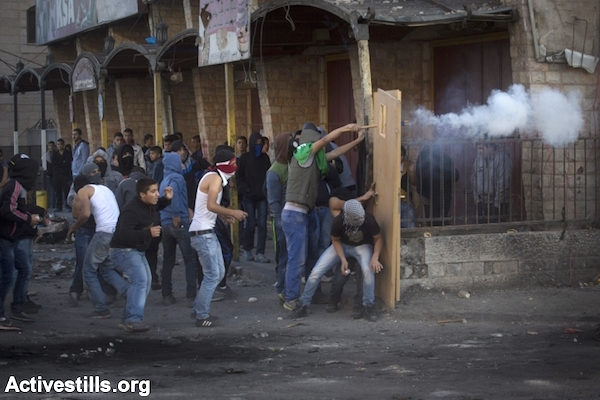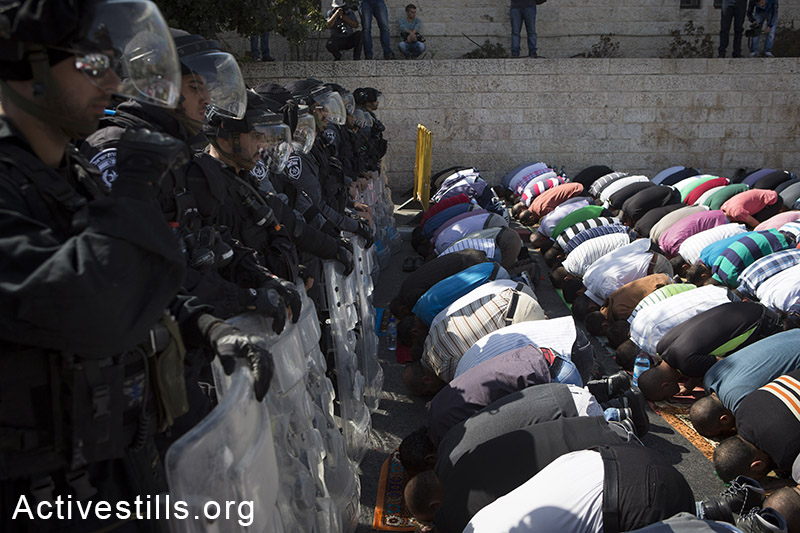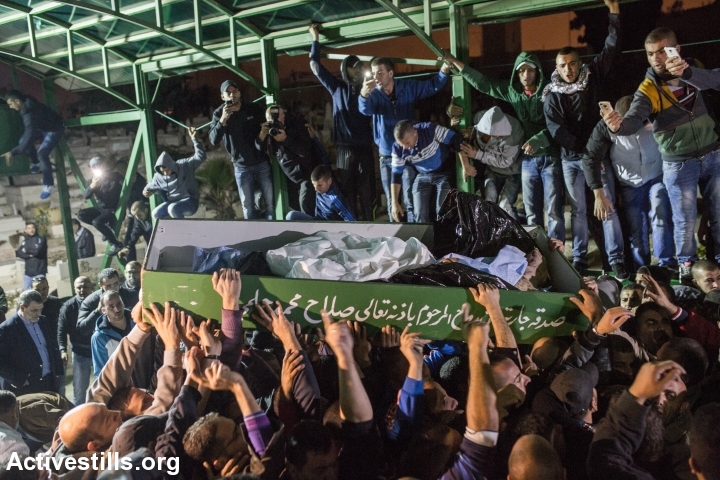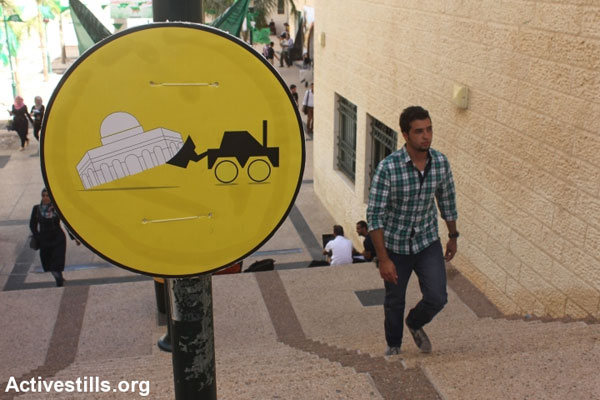From the murder of Muhammad Abu Khdeir to unrelenting settlement expansion and police harassment, the sources of anger in East Jerusalem are many. But the aspirations and provocations of right-wing Israeli Jews to change the status quo in the Aqsa Mosque compound seems to the driving force. A survey of major Palestinian newspapers.
By Henriette Chacar

Many Palestinians are calling it the “Car Intifada.” In the span of just a couple of weeks, three Palestinian residents of east Jerusalem made their vehicles into weapons and ran over pedestrians, killing four Israelis and wounding dozens more. This is hardly a new terror tactic, but the proximity of the attacks on top of intensifying tensions in Jerusalem all contributed to it its name — to it even being given a name.
So what’s going on in Jerusalem? Why is this happening now? And what is the Palestinian media’s narrative of the latest events in Jerusalem?
Since Israel seized control of Jerusalem’s Old City in 1967, during the Six Day War, Israel has vowed to maintain the status quo at the Temple Mount/Haram al-Sharif. That arrangement stipulates that non-Muslim visitors may visit but may not pray at the site. Over the years Israeli authorities have largely enforced those rules, although a series of recent events has made Palestinians increasingly suspicious of Israel’s intentions.
Photos of the month: The holy city nears its boiling point
Palestinian media was reporting perceived Israeli challenges toward the status quo on the Noble Sanctuary since early June, even before the war in Gaza broke about. The June 3rd headline in Palestine’s most widely read broadsheet, Al-Quds, read: “Israel bans Muslims, allows Jews to enter al-Aqsa Mosque.” Citing local sources, the news item mentioned that, “more than 60 extremist settlers stormed the mosque courtyards on Tuesday and performed Talmudic rituals under police protection. Meanwhile, Palestinian worshipers were prohibited from entering al-Aqsa Mosque to pray.”
Multiplying layers of anger

By June 13th, Al-Quds reported on tightening restrictions and worsening measures being taken towards Muslim worshippers, including “crackdowns, arrests and [issuing] orders banning entry to al-Aqsa for periods reaching several weeks, not to mention the confiscation of worshippers’ ID cards and the difficulties in regaining them.” It also criticizes the absence of Arab and Islamic pressure on Israel in the case of al-Aqsa.
The perceived al-Aqsa takeover was joined by yet another layer of anger in early July, after the brutal kidnapping and murder of 16-year-old Muhammed Abu Khdeir, which sparked serious protests and clashes with Israeli police in his East Jerusalem neighborhood. (When Netanyahu ordered the demolition of the vehicular attackers’ homes, many Palestinians pointed out that the prime minister never even consider demolishing the homes of the Israelis who murdered Abu Khdeir.)
By late September, just a month after the Gaza ceasefire was reached, Muslim worshippers attending the usual Friday prayers were subjected to tighter restrictions: Israeli police prohibited men under the age of 50 from entering the Aqsa Mosque compound, which it says are aimed at preventing clashes between Israeli police and Palestinians.
Many Palestinians perceive the restrictions, combined with much more frequent police-escorted visits by Jews, as a strategic measure exercised to aid far-right settler Jews in advancing their agenda of extensively “invading” the Temple Mount/Haram al-Sharif compound. A breach of the status quo to say the least.
The surreptitious takeover of 25 apartment units in the East Jerusalem neighborhood of Silwan in early October only added to the boiling Palestinian anger. Now Jewish settlers were not only provoking the status quo on the Temple Mount/Haram al-Sharif, but also invading the homes of East Jerusalem residents.
Retribution and revenge

And then there is the way that Israeli authorities and the Jerusalem Municipality pushed back against the city’s Palestinian population that it hardly serves, and which has never accepted its legitimacy. Al-Quds reported that, “teams from the Israeli Jerusalem Municipality — income tax agents and water company representatives — raided and searched shops in [the East Jerusalem neighborhoods of] Silwan, Jabal Al Mukabber, Wadi Joz and Essawiyeh. In the raid, [Israeli authorities issued] demolition orders, traffic tickets and tax fines on stores; police barricades were also set up throughout the city and [officers] were inspecting cars at random.”
Palestinian residents of East Jerusalem saw this coordinated operation as a collective punishment and harassment campaign in response to their protests against settler attacks and increasing radical Jewish infiltration to al-Aqsa, as noted by an Al-Quds report in late October.
Read also: How Likud became the Almighty’s contractor at the Temple Mount
The police killing of Muataz Hijazi, the man suspected of attempting to assassinate far-right Jewish activist Yehuda Glick, was itself depicted by Palestinian media as an assassination. Israeli police forces shot over 20 bullets into him and reportedly blocked paramedics from taking him away.
Tensions were far from assuaged when an Israeli government committee this week approved a plan for 500 new houses units in the Ramat Shlomo settlement in East Jerusalem. A week earlier, Netanyahu confirmed the advancement of 400 additional housing units for Har Homa, another once-highly contested East Jerusalem settlement.
Police enter the mosque
On Wednesday, Israeli forces stormed the Aqsa compound, for the first time since 1967 reaching al-Qibli Mosque, the main mosque within the compound. Policemen entered the mosque while carrying weapons and keeping their shoes on, which was perceived as a provocative desecration of one of the holiest places for Muslims. According to the Palestinian media reports, Israeli police assaulted worshippers inside the mosque, firing tear gas, stun grenades and rubber bullets, injuring many.
Many Palestinians were outraged by their understanding that the purpose of the police attack was to forcefully push Muslim worshippers out of the mosque’s courtyards in order to allow the entry of Israeli settlers. According to Al-Hayat al-Jadida, the Palestinian Authority’s official daily newspaper, this incident is what led Ibrahim Al-Akari to carry out a deadly attack with his car later the same day.

Palestinians take seriously Israeli right-wing radicals’ claims and declarations, as described in a front-page article of Friday’s Al-Hayat al-Jadida. Many are convinced that recent incursions into al-Aqsa and the tightened restrictions on Palestinians are part of larger plan aimed at destroying the possibility of an independent Palestinian state, with east Jerusalem as its capital.
‘The Israeli government is responsible’
Some even contend that the Jewish activists and Knesset members who are advocating for the right of Jews to pray at the Temple Mount/Haram al-Sharif are actually aspiring to destroy al-Aqsa in order rebuild the Jewish Temple.
According to a report on Thursday by Al-Ayyam, a leading Arabic-language daily published in Ramallah, Palestinians consider the events in Jerusalem to be so grave that less than two months after the end of the devastating war in Gaza, many Gazan citizens, particularly young people, see it as less harmful and disturbing than the struggle over al-Aqsa Mosque.
While Bibi blames Abu Mazen for fueling the flames in Jerusalem, Palestinians hold responsible the Israeli government and its state authorities. Rather than act with restraint and good judgment, Palestinians perceive the actions of the Israeli government to be intentionally provocative and deliberately defying.
Read also: No one left for Bibi to blame – except, of course, Abbas
One of yesterday’s headlines in Al-Hayat al-Jadida read: “Violence – Netanyahu’s Plan,” claiming that Netanyahu is actively promoting an escalation, clearly demonstrated by the settler takeover of the city, including its incursions on the Aqsa Mosque. Palestinians view these actions as violent attempts to divide al-Aqsa Mosque “spatially and temporally.”
The restrictions on Muslim worshippers praying at the mosque, coupled with the increasingly vocal Jewish far-right lobbying for permission to pray on the Temple Mount are inflaming the continued violent clashes. Put in a wider context with the murder of Mohammed Abu Khdeir, harsher enforcement and harassment in East Jerusalem, escalated settler takeovers of Palestinian homes and proliferating settlement building in in occupied East Jerusalem, the sources of Palestinian anger and protest may be better understood.
East and West Jerusalem are not only divided geographically; now more than ever, there is a sharp dichotomy in the experienced realities of the Holy City’s Jewish and Palestinian residents.
Related:
The only way to stop stone throwing is to end the occupation
There are no good guys in Jerusalem
Why the status quo on the Temple Mount isn’t sustainable
No one left for Bibi to blame – except, of course, Abbas
Born and raised in Jaffa, Henriette Chacar is an aspiring journalist. She is fascinated by Palestinian identity on local, regional and global levels. Aside from writing, she is active in various regional cooperation and community development initiatives. Follow her on Twitter: @HenrietteChacar.

